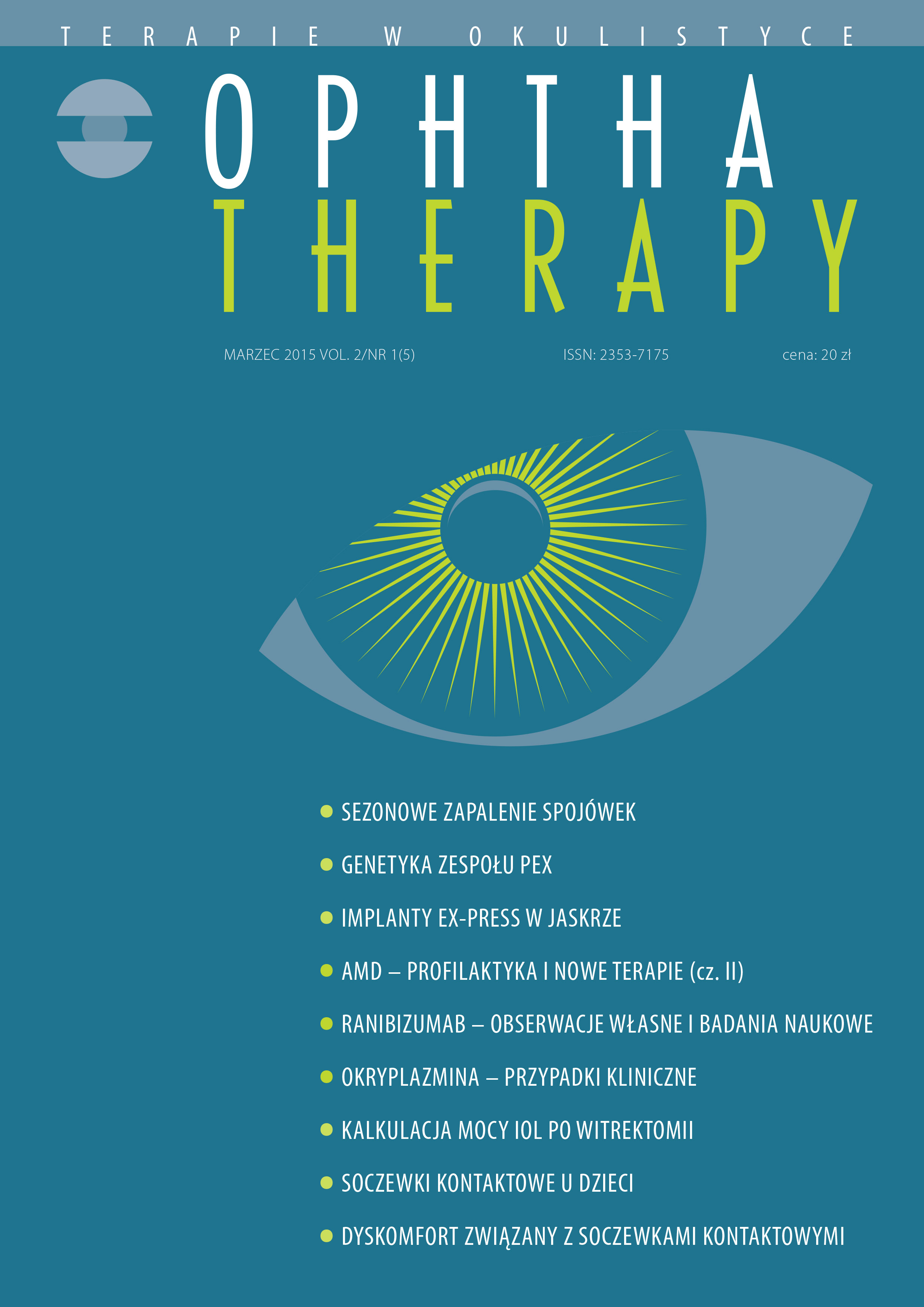When the spring comes – current therapeutic modalities for seasonal allergic conjunctivitis
Main Article Content
Abstract
Seasonal allergic conjunctivitis (SAC) is the most common type of ocular allergy. It is usually caused by sensitization to pollen. The aim of this study is to present the objective and subjective symptoms of this entity, as well as efficient and safe methods of treatment. Of particular interest is olopatadine, which is a dual-acting antihistamine/mast cell stabilizer. Also, the role of pollen in the pathomechanism of seasonal allergic conjunctivitis is explained.
Downloads
Article Details

This work is licensed under a Creative Commons Attribution-NonCommercial-NoDerivatives 4.0 International License.
Copyright: © Medical Education sp. z o.o. License allowing third parties to copy and redistribute the material in any medium or format and to remix, transform, and build upon the material, provided the original work is properly cited and states its license.
Address reprint requests to: Medical Education, Marcin Kuźma (marcin.kuzma@mededu.pl)
References
2. Leonardi A, Bogacka E, Fauquert JL et al. Ocular allergy: recognizing and diagnosing hypersensitivity disorders of the ocular surface. Allergy. 2012; 67(11): 1327-37.
3. Bielory L. Allergic and immunologic disorders of the eye. Part II: ocular allergy. J Allergy Clin Immunol. 2000; 106(6): 1019-32.
4. Zagórski Z, Naumann GOH, Watson P. Choroby rogówki, twardówki i powierzchni oka. Wydawnictwo Czelej, Lublin 2008.
5. Czajkowski J (ed). Alergiczne choroby oczu. Górnicki Wydawnictwo Medyczne, Wrocław 2003.
6. Obtułowicz K, Myszkowska D, Stępalska D. The efficacy of symptomatic treatment of pollen allergy with regard to pollen concentration – introduction of a new coefficient. Allergy Clin Immunol. 2000; 12: 105-9.
7. Rapiejko P. Alergeny pyłku roślin. Medical Education, Warszawa 2008.
8. Piotrowska-Weryszko K, Weryszko-Chmielewska E. The airborne pollen calendar for Lublin, central-eastern Poland. Ann Agricult Envir Med. 2014; 21(3): 541-5.
9. Kasprzyk I. Comparative analysis of pollen fall at three sites in south-eastern Poland. Ann Agr Envir Med. 1999; 6(1): 73-9.
10. Hofman T, Michalik J. Alergia pyłkowa. Centrum Alergologii w Poznaniu, Poznań 1998.
11. Weryszko-Chmielewska E (ed). Podręcznik aerobiologii. Uniwersytet Przyrodniczy w Lublinie, Lublin 2007.
12. Bogacka E, Górski P, Groblewska A et al. Polski konsensus diagnostyki i leczenia alergicznych chorób narządu wzroku. Alergia Astma Immunologia. 2009; 15(2): 75-86.
13. Usowska A, Rapiejko P, Lipiec A et al. Zaburzenia filmu łzowego w sezonowym alergicznym zapaleniu spojówek. Okulistyka. 2003; supl.2: 110-3.
14. Kaliner MA, Oppenheimer J, Farrar JR. Comprehensive review of olopatadine: the molecule and its clinical entities. Allergy Asthma Proc. 2010; 31(2): 112-9.
15. Abelson MB, Spitalny L. Combined analysis of two studies using the conjunctival allergen challenge model to evaluate olopatadine hydrochloride, a new ophthalmic antiallergic agent with dual activity. Am J Ophthalmol. 1998; 125: 797-804.
16. Yanni JM, Stephens DJ, Miller ST et al. The in vitro and in vivo ocular pharmacology of olopatadine (AL-4943A), an effective anti-allergic/antihistaminic agent. J Ocul Pharmacol Ther. 1996; 12: 389-400.
17. Berger WE. Once-daily olopatadine ophthalmic solution 0.2% in the treatment of allergic conjunctivitis and rhinoconjunctivitis. Expert Rev Pharmacoecon Outcomes Res. 2007; 7(3): 221-6.
18. Scoper SV. Perception and quality of life associated with the use of olopatadine 0.2% (Pataday) in patients with active allergic conjunctivitis. Adv Ther. 2007; 24(6): 1221-32.
19. Fukushima A, Ebihara N. Efficacy of olopatadine versus epinastine for treating allergic conjunctivitis caused by Japanese cedar pollen: a double-blind randomized controlled trial. Adv Ther. 2014; 31(10): 1045-58.

